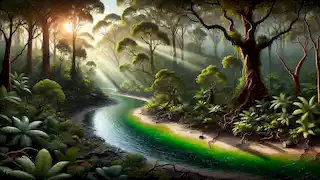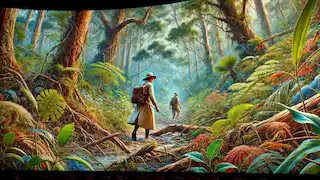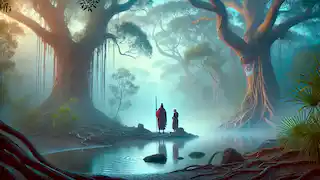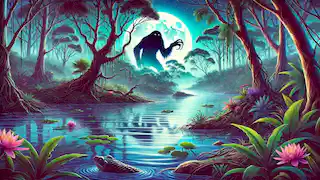In the heart of Australia lies an ancient legend, whispered among the indigenous peoples for centuries. The story of the Bunyip, a mysterious and fearsome creature that dwells in the billabongs and swamps, is one that has both fascinated and terrified generations. This tale, passed down through oral traditions, captures the essence of Australia's wild landscapes and the deep connection its people have with the natural world. Long ago, in the land of the Wiradjuri people, the elders spoke of a creature that lived in the murky waters of the Murrumbidgee River. This creature, known as the Bunyip, was said to be a guardian of the waterways, a being both revered and feared. It was described as having a large, round head, glowing eyes, and a body covered in shaggy fur. Its roar was said to be so powerful that it could be heard miles away, sending shivers down the spines of those who heard it. The river and its surrounding billabongs were vital to the Wiradjuri, providing food, water, and a place to gather and share stories. But they knew to respect the Bunyip's domain, avoiding the deepest parts of the river and the shadowy swamps where it was said to reside. The elders would often warn the young ones, "Do not wander too close to the water at night, for the Bunyip may be lurking." The land of the Wiradjuri was a place of immense natural beauty. The lush vegetation, teeming with wildlife, created an environment that was both bountiful and treacherous. The Murrumbidgee River wound its way through the landscape like a shimmering serpent, its waters dark and mysterious. The billabongs, with their still, reflective surfaces, seemed to hold secrets of their own. The people lived in harmony with the land, respecting its rhythms and cycles, and the Bunyip was an integral part of their understanding of the natural world. The Wiradjuri elders told tales of the Bunyip during gatherings around the campfire, the flickering flames casting eerie shadows that seemed to dance in time with the stories. Children listened with wide eyes, both frightened and fascinated by the descriptions of the creature. They learned that the Bunyip was not just a monster to be feared, but a protector of the waterways, ensuring that the delicate balance of nature was maintained. The stories instilled a deep respect for the land and its creatures, teaching the young ones the importance of living in harmony with their environment. In the early 1800s, as European settlers began to explore the vast Australian continent, tales of the Bunyip spread beyond the indigenous communities. One such story involves a young explorer named William. Fascinated by the legends he had heard from the Wiradjuri, William decided to venture deep into the heart of the Murrumbidgee River, determined to uncover the truth about the Bunyip. William was a man of science and adventure, driven by a thirst for knowledge and discovery. He had spent years exploring the rugged landscapes of Australia, documenting its flora and fauna, and learning from the indigenous peoples. The legend of the Bunyip intrigued him deeply, and he felt compelled to seek out the truth behind the stories. He believed that understanding the creature could unlock secrets about the natural world and the cultural heritage of the indigenous people. Armed with nothing but his journal and a sense of adventure, William set off on a small boat, paddling through the twisting waterways. As night fell, the landscape transformed into an eerie realm of shadows and strange sounds. The croaking of frogs, the rustling of leaves, and the occasional splash of water seemed to grow louder, amplifying the sense of foreboding. William anchored his boat near a secluded billabong and set up camp. He was determined to stay awake and keep watch, but the long day's journey had taken its toll. He soon found himself drifting off to sleep, lulled by the gentle lapping of the water against the shore. The night was dark and still, the air heavy with the scent of damp earth and vegetation. William's mind wandered as he lay in his makeshift camp, thinking about the stories he had heard and the creature he hoped to encounter. He wondered if the Bunyip was truly a fearsome beast or if it was simply a figment of the imagination, a symbol of the unknown. His curiosity and determination were stronger than his fear, and he resolved to stay vigilant, even as sleep tugged at his consciousness. In the dead of night, William was jolted awake by a sound unlike any he had ever heard. A deep, guttural roar echoed through the air, shaking the very ground beneath him. His heart pounded in his chest as he grabbed his lantern and peered into the darkness. The moonlight cast an eerie glow over the water, but there was no sign of the creature. Suddenly, he heard a splash, followed by the sight of ripples spreading across the surface of the billabong. William's eyes widened as he saw a massive shape rising from the depths. The creature's glowing eyes locked onto him, and for a moment, he was paralyzed with fear. The Bunyip's presence was overwhelming, its sheer size and power beyond anything he had imagined. The creature's head emerged from the water, its eyes glowing like embers in the darkness. William could see the shaggy fur covering its massive body, glistening with water. The Bunyip's roar reverberated through the night, a sound that seemed to shake the very soul. William's mind raced as he struggled to comprehend what he was seeing. He had read about the Bunyip in legends, but witnessing it in person was an entirely different experience. Summoning all his courage, William fumbled for his journal and began scribbling notes, his hands shaking uncontrollably. He knew he had to document this encounter, even if it meant risking his life. The Bunyip let out another roar, this time closer, and William realized he needed to leave before it was too late. He quickly packed his belongings and paddled away, his mind racing with thoughts of what he had just witnessed. As he paddled furiously through the dark waters, William couldn't shake the image of the Bunyip from his mind. He replayed the encounter over and over, trying to make sense of what he had seen. The creature was unlike anything he had ever encountered, a being that defied explanation. He wondered if it was a guardian spirit, as the Wiradjuri believed, or if it was something else entirely. The experience left him with more questions than answers, but it also filled him with a sense of awe and respect for the ancient legends. After what felt like an eternity, William reached the safety of a nearby settlement. Exhausted and shaken, he shared his story with the locals, who listened in awe and disbelief. His journal, filled with detailed descriptions and sketches of the Bunyip, became a source of fascination for many. Some dismissed his tale as the ramblings of an overactive imagination, while others believed he had truly encountered the legendary creature. William's encounter with the Bunyip reignited interest in the ancient legend, and soon, stories of sightings and encounters spread across the region. The indigenous people, who had always known of the Bunyip's existence, were both intrigued and concerned by the growing attention. They feared that the increased interest might disrupt the delicate balance between their world and the Bunyip's domain. The settlers and explorers who heard William's story were captivated by the mystery of the Bunyip. Some saw it as an opportunity for fame and fortune, hoping to capture the creature and prove its existence to the world. Others, however, felt a deep sense of reverence for the legend and the culture it represented. They understood that the Bunyip was not just a creature to be hunted, but a symbol of the profound connection between the land and its people. William's journal became a treasured artifact, passed from hand to hand, sparking debates and discussions. Scholars and scientists pored over his notes, trying to piece together the truth behind the legend. The indigenous communities, meanwhile, continued to share their stories and wisdom, emphasizing the importance of respecting the natural world and the creatures that inhabited it. Years later, a renowned scholar named Dr. Eleanor Martin took an interest in the legend of the Bunyip. Driven by a passion for uncovering the truth behind myths and folklore, Dr. Martin embarked on a journey to the Murrumbidgee River. Armed with the accounts of William and the stories of the Wiradjuri people, she sought to learn more about the creature that had eluded so many. Dr. Martin was a dedicated and meticulous researcher, known for her work in anthropology and natural history. She had spent years studying the myths and legends of various cultures, and the story of the Bunyip intrigued her deeply. She believed that understanding the Bunyip could provide valuable insights into the relationship between humans and the natural world, as well as the cultural heritage of the indigenous people. Dr. Martin spent months living among the indigenous communities, learning their language and traditions. She listened to their stories, gathered clues, and meticulously documented every detail. The more she learned, the more she realized that the Bunyip was not merely a creature of legend, but a symbol of the deep connection between the people and the land. One evening, while discussing her findings with an elder, Dr. Martin was told of a sacred site deep within the swamps where the Bunyip was believed to reside. With the elder's guidance, she prepared for a journey to this sacred place, hoping to uncover the truth once and for all. The elder, a wise and respected figure in the community, shared the stories of his ancestors, describing the Bunyip as a guardian spirit that protected the waterways and ensured the balance of nature. He explained that the Bunyip's roars were not cries of anger, but warnings to those who threatened the harmony of the land. Dr. Martin listened intently, feeling a deep sense of reverence for the wisdom and knowledge of the indigenous people. The journey to the sacred site was arduous, taking Dr. Martin through dense forests and treacherous marshlands. The air was thick with humidity, and the sounds of wildlife surrounded her. As she ventured deeper into the swamps, she felt a growing sense of reverence and anticipation. Finally, she reached the site—a secluded billabong, shrouded in mist and ancient trees. The elder performed a ritual, calling upon the spirits of the land to guide and protect them. Dr. Martin watched in awe as the mist began to clear, revealing a tranquil pool of water. She felt an overwhelming sense of peace and connection, as if the land itself was welcoming her. As night fell, the elder spoke of the Bunyip, explaining that it was a guardian spirit, a protector of the waterways. The Bunyip's roars were not cries of anger, but calls of warning, reminding the people to respect the natural world. Dr. Martin realized that the legend of the Bunyip was more than just a story—it was a reminder of the harmony that must exist between humans and nature. Dr. Martin spent hours at the sacred site, meditating and reflecting on the stories she had heard. She felt a deep sense of connection to the land and its creatures, understanding that the Bunyip was a symbol of the delicate balance that must be maintained. The experience was transformative, filling her with a renewed sense of purpose and commitment to preserving the cultural heritage of the indigenous people. Dr. Martin returned from her journey with a renewed sense of purpose. She dedicated her life to preserving the stories and traditions of the indigenous people, ensuring that the legend of the Bunyip would be passed down to future generations. Her work helped to bridge the gap between the ancient wisdom of the Wiradjuri and the modern world, fostering a deeper understanding and appreciation of Australia's rich cultural heritage. Dr. Martin's research was published in numerous journals and books, bringing the story of the Bunyip to a wider audience. She worked tirelessly to promote the importance of cultural preservation, collaborating with indigenous communities to document their stories and traditions. Her efforts helped to raise awareness about the significance of the Bunyip and the need to respect and protect the natural world. The legend of the Bunyip continues to be a source of fascination and inspiration. It serves as a reminder of the mysteries that still lie hidden within the natural world and the importance of respecting and protecting the environment. The Bunyip's legacy lives on in the stories, art, and traditions of the people, a testament to the enduring power of myth and the timeless bond between humans and nature. Through Dr. Martin's work, the legend of the Bunyip became a symbol of the deep connection between humans and the natural world. It highlighted the importance of understanding and respecting the cultural heritage of indigenous peoples, recognizing the wisdom and knowledge they possessed. The story of the Bunyip served as a reminder that the land and its creatures were not to be taken for granted, but cherished and protected. In the quiet moments of dusk, when the sky is painted with hues of orange and pink, the waters of the Murrumbidgee River still hold a sense of mystery. Those who venture close may hear the distant call of the Bunyip, a low, haunting sound that echoes through the trees. It is a call that speaks of ancient times, of guardianship and respect, a reminder that the spirit of the Bunyip lives on, watching over the land and its people. And so, the legend of the Bunyip endures, a timeless tale that continues to captivate and inspire, a symbol of the deep connection between the land, its creatures, and those who call it home. The story of the Bunyip is not just a tale of mystery and adventure, but a profound reminder of the importance of living in harmony with the natural world. It teaches us to respect the land and its creatures, to listen to the wisdom of the indigenous peoples, and to appreciate the beauty and wonder that exists all around us. The Bunyip's call is a call to each of us, urging us to protect and preserve the delicate balance of nature for future generations.The Mysterious Waters

The Lost Explorer

A Frightful Encounter
The Return to Safety

The Scholar's Quest
The Sacred Site

The Bunyip's Legacy
Epilogue: The Bunyip's Call

The Legend of the Bunyip
Reading Time: 13 min

About Story: The Legend of the Bunyip is a Legend Stories from australia set in the 19th Century Stories. This Descriptive Stories tale explores themes of Nature Stories and is suitable for All Ages Stories. It offers Cultural Stories insights. Unravel the mysteries of Australia's legendary water guardian.


















